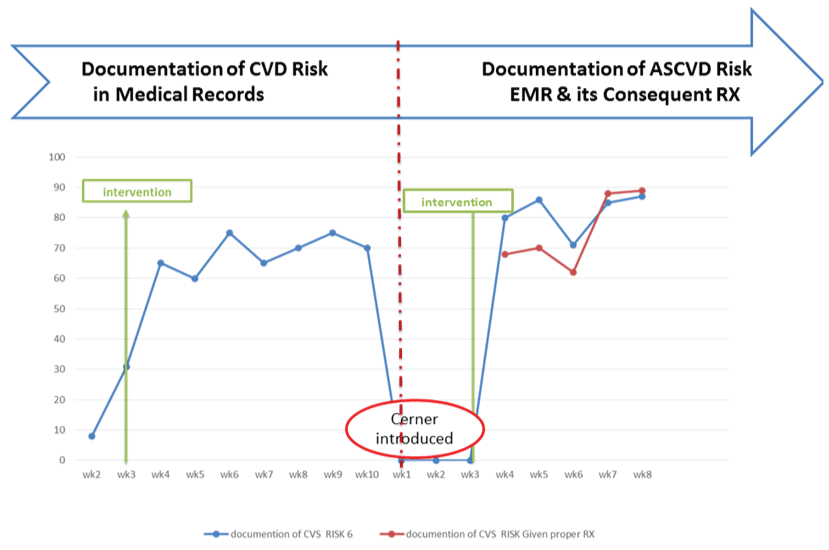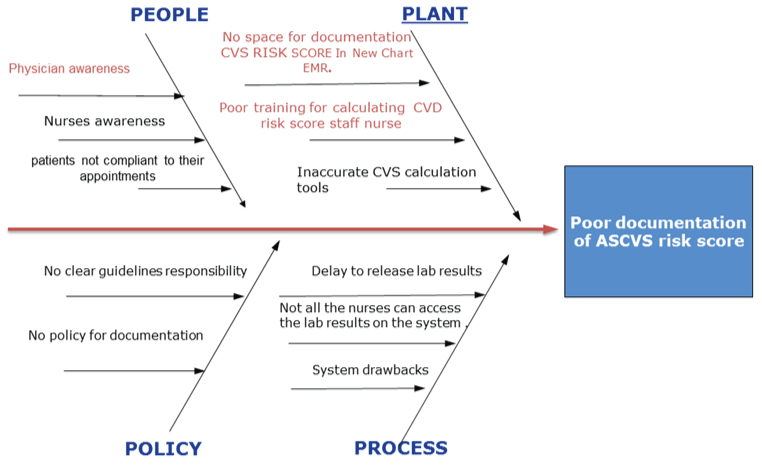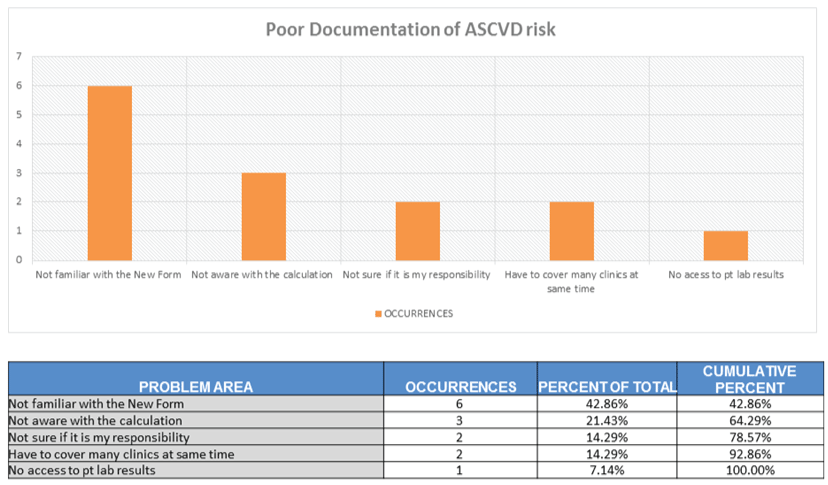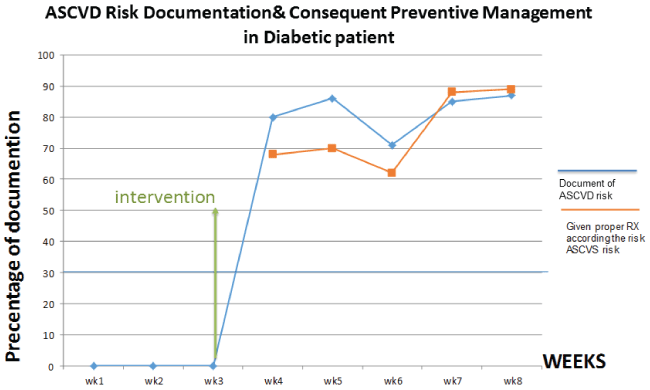International Journal of Clinical Cardiology
Improving Atherosclerotic Cardiovascular Risk Documentation and Consequent Preventive Management in the Electronic Medical Records of Diabetic Patients
Muna aseel1, Amal Al-Ali1, Zelaikha Alwahedi1 and Mohamed Salem2*
1Primary Health Care, Qatar
2Suez Canal University, Egypt
*Corresponding author: Mohamed Salem, Suez Canal University, Egypt, E-mail: m_salem1973@yahoo.com
Int J Clin Cardiol, IJCC-3-077, (Volume 3, Issue 1), Research Article; ISSN: 2378-2951
Received: February 12, 2016 | Accepted: May 14, 2016 | Published: May 18, 2016
Citation: Aseel M, Al-Ali A, Alwahedi Z, Salem M. (2016) Improving Atherosclerotic Cardiovascular Risk Documentation and Consequent Preventive Management in the Electronic Medical Records of Diabetic Patients. Int J Clin Cardiol 3:077. 10.23937/2378-2951/1410077
Copyright: © 2016 Aseel M, et al. This is an open-access article distributed under the terms of the Creative Commons Attribution License, which permits unrestricted use, distribution, and reproduction in any medium, provided the original author and source are credited.
Abstract
Background: Proper documentation of Atherosclerotic Cardiovascular Disease (ASCVD) risk score and its consequent management in the newly applied electronic medical records (EMR) for diabetic’s patients attending non-communicable diseases clinic in West Bay Health Center is less than ideal during Jan 2015 and Feb 2015. Poor documentation of ASCVD risk score and its consequent management will result in improper management for type 2 diabetic patients, and it will lead to undesirable consequences.
Aim: To improve the documentation of ASCVD risk score and its consequent management in the EMR of diabetic patients attending non communicable disease clinic (NCD) at west bay health center in accordance to American Heart Association and American College of Cardiology (AHA/ACC) guidelines for ASCVD risk assessment by end of April 2015.
Methods: Pre-intervention Checklist was developed to collect baseline data regarding the percentage of documentation of ASCVD risk score and its consequent management from the EMR for 60 Diabetic Patients attends NCD clinics. Intervention in the form of training session was done for all NCD nurses regarding the importance of ASCVD risk score Calculation method and role of nurses in documentation. For all doctors that run the NCD clinic training session was done regarding the ASCVD risk score interpretation, documentation, and importance of preventive management based on the score calculated with allocation of space in the new NCD chart in EMR for ASCVD risk score documentation and consequent management based on the score calculated and create a reminder poster in NCD nurse station and NCD clinics.
Results: Percentage of complete ASCVD risk documentation for diabetic patients in electronic medical (EMR) increased to 87% with given proper treatment based on the calculated score after the intervention.
Conclusions: Intervention in the form of nurse and physician Training improved the documentation of ASCVD by 87 %. This usually raise the issue that while implementing new systems, we must put into consideration previous processes and making suitable improvements.
Keywords
ASCVD, Documentation, Management, Electronic medical records, Diabetic patients
Abbreviations
ASCVD: Atherosclerotic Cardiovascular Disease; ACS: Acute Coronary Syndrome; CVD: Cardiovascular Disease; CHD: Coronary Heart Disease; NCL: Non Communicable Disease Clinic; LLT: Lipid Lowering Treatment; EMR: Electronic Medical Records; LDL-c: Low Density Lipoprotein; AHA/ACC: American Heart Association and American College of Cardiology
Introduction
Proper documentation of ASCVD score and its consequent management in the newly applied electronic medical records (EMR) for diabetic’s patients attending non-communicable diseases clinic in West Bay Health Center in Qatar is less than ideal during Feb 2015. Poor documentation of ASCVD risk score and its consequent management will result in improper management for type 2 diabetic patients, and it will lead to undesirable consequences.
Approximately 15% of the U.S. adult population has either ASCVD or diabetes with 7% being either recent Acute Coronary Syndrome (ACS) or stable Coronary Heart Disease (CHD), and 6% having diabetes without ASCVD. Only 55% of this population was treated with Lipid Lowering Treatments (LLT) with a subset attaining LDL-C targets, suggesting under-treatment of this high-risk population [1].
Assessment of 10-year risk of a first atherosclerotic cardiovascular (ASCVD) event is recommended by the 2013 ACC/AHA Guidelines on the Treatment of Blood Cholesterol to Reduce Atherosclerotic Cardiovascular Risk in adults with moderate-intensity statin therapy should be initiated or continued for adults 40 to 75 years of age with diabetes mellitus and High-intensity statin therapy is reasonable for adults 40 to 75 years of age with diabetes mellitus with a ≥ 7.5% [2].
In all patients with diabetes aged more than 40 years, and if clinically indicated, moderate intensity statin treatment should be considered, in addition to lifestyle therapy, clinical trials in high-risk patients, such as those with acute coronary syndromes or previous cardiovascular events have demonstrated that more aggressive therapy with high doses of statins led to a significant reduction in further events [3,4].
Methods
Baseline measurement
The project began 15th February 2015, baseline audit to determine the percentage of ASCVD risk documentation, it was 0%. Brain storming session was done to identify the causes of such problem including fish bone analysis in figure 1, Survey questionnaire was designated to assess the main causes of the problem and distributed to all nurses working in NCD clinics (pre-intervention checklist survey) table 1, The results of this survey demonstrated in Pareto chart in figure 2, the main causes of the problem lies on two main causes (nurses were not oriented to documentation process in the new EMR, and some of them were not trained to calculate ASCVD risk). See figure 1 Fish Bone analysis, table 1 pre-intervention checklist survey and figure 2 Pareto Chart.
![]()
Table 1: Pre-intervention check list survey of nurses.
View Table 1
Design
Training session for nurses working in NCD clinics were done particularly on: Orientation about new EMR format and ASCVD risk documentation, Education sessions for NCD clinic running physicians, Putting reminder posters in NCD clinics and staff nurse stations, and Several audits done retrospectively weekly for five weeks to show average percentage of documentation.
***See supplementary file 1 and supplementary file 2 attached on how to calculate ASCVD score and subsequent management plan respectively.
Strategy
Pre-intervention Checklist was developed to collect baseline data regarding the percentage of documentation of ASCVD risk score and its consequent management from the EMR for 60 Diabetic Patients attends NCD clinics table 2. Intervention in the form of training session was done for all NCD nurses regarding the importance of ASCVD risk score Calculation method and role of nurses in documentation. For all doctors that run the NCD clinic training session was done regarding the ASCVD risk score interpretation, documentation, and importance of preventive management based on the score calculated with allocation of space in the new NCD chart in EMR for ASCVD risk score documentation and consequent management based on the score calculated and create a reminder poster in NCD nurse station and NCD clinics. In improvement cycle (1), there was improvement of cardiovascular disease documentation in medical records of diabetic patients according to WHO charts and Framingham scores figure 3 while in improvement cycle (2), there is introduction of electronic medical records and new guidelines based on ASCVD risk score assessment and management ACC/AHA 2013 as shown in figure 4.
![]()
Table 2: Pre-intervention checklist for ASCVD documentation.
View Table 2
Results
Percentage of complete ASCVD risk documentation for diabetic patients in electronic medical (EMR) increased to 87% with given proper treatment based on the calculated score after the intervention, While compliance to management increases to be 90%. All data was demonstrated using run chart, figure 4.

.
Figure 3: Cardiovascular disease risk documentation in medical records before and after introduction of electronic medical records.
View Figure 3
Lessons and Limitations
Number of lessons learnt from this project including that Training is one of the most powerful way to influence health care compliance to ASCVD risk documentation, Sharing physician and nurses in team work to achieve goals is very important to patient outcome also Sustainability is very important for success in any improvement project.
Conclusion
Intervention in the form of nurse and physician Training improved the documentation of ASCVD by 87%, this usually raise the issue that while implementing new systems, we must put into consideration previous processes and making suitable improvements.
Declaration of Interests
Nothing to declare
Acknowledgements
We would like to acknowledge Dr. Hani Abdullaha, Resident Family Medicine Hamad Medical Corporation, Mr. Ady Candra, Document Controller at Family Medicine, PHCC.
Ethical Approval
Consent obtained from Primary Health Care Corporation and confidentiality is ensured at all phases of project implementation.
References
-
Katherine Gorcyca, Irfan Khan, Rishi Wadhera, Alexa Klimchak, Katherine Gooch, et al. (2015) Prevalence of Atherosclerotic Cardiovascular Disease (ASCVD) and Diabetes Populations in the United States. Journal of Clinical Lipidology 9: 424.
-
Heart Association Task Force on Practice Guidelines: A Report of the American College of Cardiology/American 2013 ACC/AHA Guideline on the Treatment of Blood Cholesterol to Reduce Atherosclerotic Risk in Adults.
-
(2015) Standards of Medical Care in Diabetes. Diabetes Care 38: 1.
-
Salem M, Al-Ali A, Bashwar Z (2015) Improving documentation of cardiovascular disease risk in patients with diabetes attending non communicable disease clinics at West Bay Health Center in Qatar. BMJ Qual Improv Report 4: w3190.








